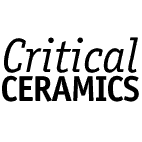


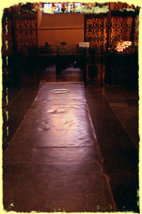
Inside the cathedral


Facade rubble

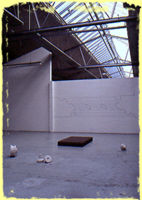
Transept installation view


Transept installation view
Denise Pelletier & Jason Green
“... The interesting thing about idea spaces and memory systems is that they presuppose the existence of some sort of place, either real or graphic, which has it’s own structure or architecture. There is always a whole space, which already exists in its entirety, onto which ideas and images can be mapped, using only a portion of the space needed.
In addition to the familiar model of prerecorded time unfolding along a linear path, (as evidenced by many things from our writing system to the thread of magnetic tape playing in a videotape recorder), there is another parallel to be linked with modern technology. “Data space” is a term we hear in connection with computers. Information must be entered into a computer’s memory to create a set of parameters, defining some sort of ground or field, where future calculations and binary events occur. In three dimensional computer graphics, this field exists as an imaginary but real chunk of space, a conceptual geometry, theoretically infinite, within which various forms may be created, manipulated, extended, and destroyed. The graphics display screen becomes that mysterious third point of view looking in on this space (we often call it our “minds eye”), which can be moved about and relocated from any angle at will. The catch is that the space must exist in the computer first, so that there is a reference system within which to locate the various coordinates or points and lines called into being by the operator. In our brain, constantly flickering pulses of neuron firings create a steady-state field onto which disturbances and perturbations are registered as percepts and thought forms...”
Bill Viola, Reasons for Knocking at an Empty House, (pages 100-101)
During the summer of 1999, a group of artists and students from France, England, Spain, The Netherlands and the United States were invited to the Dutch city of ’s-Hertogenbosch to participate in the workshop, Beyond Gravity: Ceramics in a Digital Culture. The workshop was organized in collaboration with the Museum het Kruithius, Hogeschool’s-Hertogenbosch, European Ceramic Work Center, and the Dutch Design Institute as a special event in association with the “Ceramic Millennium 㥫” conference held in Amsterdam. Participants were asked to respond to Arthur Danto’s essay, Handedness and Postmodern Art written for the workshop, and to consider questions relating to “the impact of digitalization of our lives and culture...” by incorporating digital technology with ceramic material and process. Artists shared a ceramic studio, digital lab and other facilities at the Hogeschool ’s-Hertogenbosch, Academy of Art and Design, while living together in a shared environment.
’s-Hertogenbosch is a small city located an hour by train from Amsterdam and is home to the European Ceramic Work Center where the workshop leaders Nicolaas Dings, Walter McConnell, Pjotr Muller and Thom Puckey have all worked as resident artists. Artists were also assisted by Jeroen Bechtold who designs “virtual ceramics” as well as Dutch students who were proficient in CAD-CAM programs. We, two American artists, were invited to participate alongside the students and workshop leaders. Together, we created a work which was installed at the Academy of Art and Design and addressed the ideas initiated by the workshop.
Our strategy of working was defined through the ideas and mission of the workshop as well as in conversations we had prior to arriving in the Netherlands. We had discussed the potential of working together, identifying our common artistic concerns and methodologies. We share a number of fundamental interests that find their way into our respective work - memory, history, the constancy of dissolution and regeneration, a love of commonplace objects - and a way of working that allows process and improvisation to effect concept and form. We were both interested in the idea of collaborating on a work which might somehow correlate new information technologies, a point of view relative to the question of handedness, and our observations and experience of the Netherlands as a place and culture.
Further, our initial conversations revealed a similarity in our working strategies, especially our reliance on material, process and chance to guide and mediate concept. In addition, research, in its many forms, is one of the most important tools we use in our individual work. We love to know the history of things, the meanings and origins of words, and the importance of language in forming meaning between images, ideas and objects. Finally, both of us are sensitive to the ideas and experiences conveyed by specific places.
The workshop provided fertile ground for probing the intersections between existing, fabricated and virtual contexts. It was our hope that research into these intersections would provide an intimate understanding of our subject and help create a work that not only relied upon, but generated, context. In the research phase, our collaboration was a filter that captured images and information for later examination. In our new surroundings, we quickly focused on collecting images. Armed with a digital camera, our research process began. Our initial aim was to experience and absorb our present technological and physical being within this unfamiliar place. As artists, we posed as tourists spontaneously reacting to and documenting architectural spaces, intimate places, land and local color. Later, we would become scientists, examining and indexing our digital specimens in the computer lab.
As we walked along the cobble streets of ’s-Hertogenbosch, a swarm of commuters passed us on bicycles, the dominant form of local transport in the Netherlands. Our surroundings were remarkably dissimilar to those we were accustomed to in the United States. One of the things we found particularly striking was the unique and pervasive sense of order that we observed in the landscape and culture. From living room windowsills, precisely spaced figurines faced outwards; canals bordered many of the streets, circulating and connecting an expansive, orderly, network. Locks and pumps controled the level of the water like artificial tides. We were reminded that the majority of Holland is below sea level, and we were curious about the relationship of the cultural order to the physical necessity of holding water back.
We entered Sint Janskathedraal through a side door flanked by the foundations of flying buttresses. It is a gothic church, the towns largest building, and a historical landmark located in the heart of the city. Nearly half of its exterior was enveloped by scaffolding in what, we were told, was a perpetual restoration of the facade. Once inside the cathedral, we were drawn to the floor; its massive black stones shone softly like burnished clay. Standing upon graves which seemed to make up the foundation of the cathedral, we struggled to decipher the stones’ inscriptions. The ornate carvings invited investigation, revealing names, numbers, family crests, skulls and chalices. Single letters were the only sign on several of the small stones. These markings, along with some numerical inscriptions we found, seemed to relate to the location of the stones in the cathedral. There appeared to be a sort of coordinate or mapping system on the floor. Soft edged shallow depressions created by the pressure of feet were all that remained on many stones. We had become participants in the erosion of the floor - we imagined an accumulation of dust from the generations of abrasion and were reminded of the temporality of even the most permanent materials. The cathedral provided us the space to reflect upon the links between the physical and the ephemeral, the material and the virtual.
We revisited the cathedral the following day to take rubbings from the floor, to record images, inscriptions and impressions. While exploring the niches, alters, and chambers of the vast space, we discovered a book which held detailed architectural diagrams of the cathedral. These were not plans, but rather maps of the cathedral. Some of the schematics of moldings, crown frames and window supports recalled maps of land and water masses with their horizontal lines connecting architectural profiles. The mathematical precision of the drawings, with their numbered coordinates and vector lines, made them look surprisingly like CAD prints. We began to see in them an opportunity to visually and conceptually link ancient and modern technologies, time, place and culture.
Our work together required constant conversation in which we evaluated our physical recordings, feelings, and observations. Collaboration between individuals requires verbalization, which can sometimes be difficult in a creative process which does not always rely on logical reasoning. Thus, it was important for us to think of ourselves as a team, to be willing to take risks and communicate clearly. Our collaboration evolved by enlisting a working strategy that would allow us to discover our subject rather than determine it. In this way, the collaboration could become an entity in itself; that is, a network with a self directing system and process.
Through our conversations, studies, photographs, and rubbings, we began creating a mapped relation between the different elements. First, we anchored the installation with a monolithic rectangle of rammed clay dredged from a local river, burnished smooth in an effort to echo the stone of the cathedral floor. The surface of the slab reflected light and cracked as if it had been subject to great stress. The cracks were the result of shrinkage caused by the evaporation of water — the crevasses growing imperceptibly with the passage of time. The linear qualities of the cracks invite association with a black chalk line drawing made by projecting an image of the church’s south transept window supports on an adjacent wall. While the drawing appears to be a map of land and water, in reality it is an enlarged architectural diagram.
Plaster objects were placed on the floor around the clay monolith; each located by a reproduction of a rubbing taken from the floor. The plaster objects were carved on a lathe using templates based on profiles in the wall drawing, and their arrangement on the floor corresponds to points in the drawing. The rubbings consisted of numbers and letters which suggested a coordinate system. They were scanned, digitally enhanced, transferred to silkscreen and printed on the floor using ceramic stain. The milky white solid forms contrasted with the dark gray impermanent ceramic pigments of the coordinates and the chalk of the wall drawing.
Context itself can be treated as an object. This is to say that we are interested in the unfixed and shifting relationship which emerges between objects selected, alluded to, and made. These relationships are as much a substance in the making of a work as the material and process. These linkages are what we find really interesting — the oscillation that occurs between things which continually modify and redefine one another because of their relationship.
Ironically, our ability and sensitivity as crafts people, trained in the methods of the hand , seemed to negate any individual style in the final installation. Either of us could have performed any of the tasks with no real qualitative difference. The processes we chose - tracing, printing, pounding clay into a cottle and turning forms on a lathe - all involved the hand without revealing a signature. We did not, however, sacrifice our, or the viewers’, tactile experiences. Elements from within the installation, such as the surface of the slab of river clay, echo the methods and labor used during construction. Our efforts employed in production shared physical and repetitious aspects that were simultaneously mechanical and corporeal, not unlike the renovation of the cathedral itself. In some sense, the making of the installation was performative, reinforcing the temporality of the artwork.
As Danto points out, craft, and ceramics in particular, has been plagued by the art versus craft (idea versus hand) debate; meanwhile, some artists have been paving an avenue of expression which utilizes technology and information as material. Is it possible, or even desirable, for ceramists to begin using this digital flux? How would we, as artists trained in a primordial medium - earth, fire, water - incorporate digital media? If craft is, as Danto puts forth, an “unanticipated product of the industrial revolution”, would we, as ceramists, be robbing the medium by producing apparently “handless” artwork? We question if (and how) the incorporation of digital technology into the creative processes has extended or redefined the concept of craft. As society increasingly turns to virtuality and the immaterial, we are faced with reconsidering the importance of physicality both as act and object. In our collaboration, technology was simultaneously treated as tool, source, and material. Even with the inclusion of digital technology in our creative process, our work maintains a commitment to the hand.
Jason Green received his MFA in Ceramics from the New York State College of Ceramics at Alfred University in 1998 and currently teaches at Walnut Hill School in Natick, MA. His objects and installations have been exhibited at Real Art Ways, Artspace Gallery, and New Space Gallery in Connecticut. In 1999 he was the Standard Ceramics Resident at Watershed Center for the Ceramic Arts.
Denise Pelletier received and MFA in Ceramics from the New York State College of Ceramics at Alfred University in 1994. She has taught at the University of Connecticut, Ithica College, and State University of New York College at Cortland, and will be teaching at the New York State College of Ceramics at Alfred University as Visiting Assistant Professor during the spring of 2000. She exhibits her work nationally, and has recently been awarded a summer residency in the John Michael Kohler Arts/Industry Program.

River clay slab

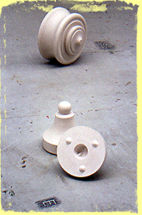
Transept detail

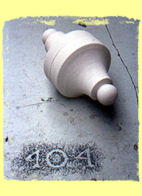
Transept detail